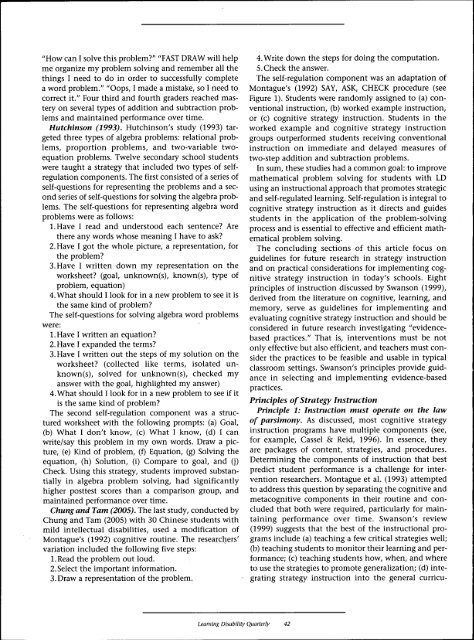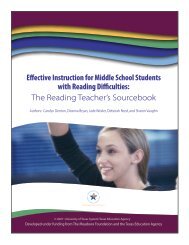Self-regulation strategies to improve mathematical problem solving
Self-regulation strategies to improve mathematical problem solving
Self-regulation strategies to improve mathematical problem solving
You also want an ePaper? Increase the reach of your titles
YUMPU automatically turns print PDFs into web optimized ePapers that Google loves.
"How can I solve fhis <strong>problem</strong>?" "FAST DRAW will belpme organize my <strong>problem</strong> <strong>solving</strong> and remember all thethings I need <strong>to</strong> do in order <strong>to</strong> successfully completea word <strong>problem</strong>." "Oops, I made a mistake, so I need <strong>to</strong>correct it." Four third and fourth graders reached masteryon several types of addition and subtraction <strong>problem</strong>sand maintained performance over time.Hutchinson (1993). Hutchinson's study (1993) targetedthree types of algebra <strong>problem</strong>s: relational <strong>problem</strong>s,proportion <strong>problem</strong>s, and two-variable twoequation<strong>problem</strong>s. Twelve secondary school studentswere taught a strategy that included two types of self<strong>regulation</strong>components. The first consisted of a series ofself-questions for representing the <strong>problem</strong>s and a secondseries of self-questions for <strong>solving</strong> the algebra <strong>problem</strong>s.The self-questions for representing algebra word<strong>problem</strong>s were as follows:l.Have I read and unders<strong>to</strong>od each sentence? Arethere any words whose meaning I have <strong>to</strong> ask?2. Have I got the whole picture, a representation, forthe <strong>problem</strong>?3. Have I written down my representation on theworksheet? (goal, unknown(s), known(s), type of<strong>problem</strong>, equation)4. What should I look for in a new <strong>problem</strong> <strong>to</strong> see it isthe same kind of <strong>problem</strong>?The self-questions for <strong>solving</strong> algebra word <strong>problem</strong>swere:l.Have I written an equation?2. Have I expanded the terms?3. Have I written out the steps of my solution on theworksheet? (collected like terms, isolated unknown(s),solved for unknown(s), checked myanswer with the goal, highlighted my answer)4. What should I look for in a new <strong>problem</strong> <strong>to</strong> see if itis the same kind of <strong>problem</strong>?The second self-<strong>regulation</strong> component was a structuredworksheet with the following prompts: (a) Goal,(b) What I don't know, (c) What I know, (d) I canwrite/say this <strong>problem</strong> in my own words. Draw a picture,(e) Kind of <strong>problem</strong>, (f) Equation, (g) Solving theequation, (h) Solution, (i) Compare <strong>to</strong> goal, and (j)Check. Using this strategy, students <strong>improve</strong>d substantiallyin algebra <strong>problem</strong> <strong>solving</strong>, had significantlyhigher posttest scores than a comparison group, andmaintained performance over time.Chung and Tam (2005). The last study, conducted byChung and Tam (2005) with 30 Chinese students withmild intellectual disabilities, used a modification ofMontague's (1992) cognitive routine. The researchers'variation included the following five steps:l.Read the <strong>problem</strong> out loud.2. Select the important information.3.Draw a representation of the <strong>problem</strong>.4. Write down the steps for doing the computation.5. Check the answer.The self-<strong>regulation</strong> component was an adaptation ofMontague's (1992) SAY, ASK, CHECK procedure (seeFigure 1). Students were randomly assigned <strong>to</strong> (a) conventionalinstruction, (b) worked example instruction,or (c) cognitive strategy instruction. Students in theworked example and cognitive strategy instructiongroups outperformed students receiving conventionalinstruction on immediate and delayed measures oftwo-step addition and subtraction <strong>problem</strong>s.In sum, these studies had a common goal: <strong>to</strong> <strong>improve</strong><strong>mathematical</strong> <strong>problem</strong> <strong>solving</strong> for students with LDusing an instructional approach that promotes strategicand self-regulated learning. <strong>Self</strong>-<strong>regulation</strong> is integral <strong>to</strong>cognitive strategy instruction as it directs and guidesstudents in the application of the <strong>problem</strong>-<strong>solving</strong>process and is essential <strong>to</strong> effective and efficient <strong>mathematical</strong><strong>problem</strong> <strong>solving</strong>.The concluding sections of this article focus onguidelines for future research in strategy instructionand on practical considerations for implementing cognitivestrategy instruction in <strong>to</strong>day's schools. Eightprinciples of instruction discussed by Swanson (1999),derived from the literature on cognitive, learning, andmemory, serve as guidelines for implementing andevaluating cognitive strategy instruction and should beconsidered in future research investigating "evidencebasedpractices." That is, interventions must be no<strong>to</strong>nly effective but also efficient, and teachers must considerthe practices <strong>to</strong> be feasible and usable in typicalclassroom settings. Swanson's principles provide guidancein selecting and implementing evidence-basedpractices.Principles of Strategy InstructionPrinciple 1: Instruction must operate on the lawof parsimony. As discussed, most cognitive strategyinstruction programs have multiple components (see,for example, Cassel & Reid, 1996). In essence, theyare packages of content, <strong>strategies</strong>, and procedures.Determining the components of instruction that bestpredict student performance is a challenge for interventionresearchers. Montague et al. (1993) attempted<strong>to</strong> address this question by separating the cognitive andmetacognitive components in their routine and concludedthat both were required, particularly for maintainingperformance over time. Swanson's review(1999) suggests that the best of the instructional programsinclude (a) teaching a few critical <strong>strategies</strong> well;(b) teaching students <strong>to</strong> moni<strong>to</strong>r their learning and performance;(c) teaching students how, when, and where<strong>to</strong> use the <strong>strategies</strong> <strong>to</strong> promote generalization; (d) integratingstrategy instruction in<strong>to</strong> the general curricu-Leaming Disability Quarterly 42












